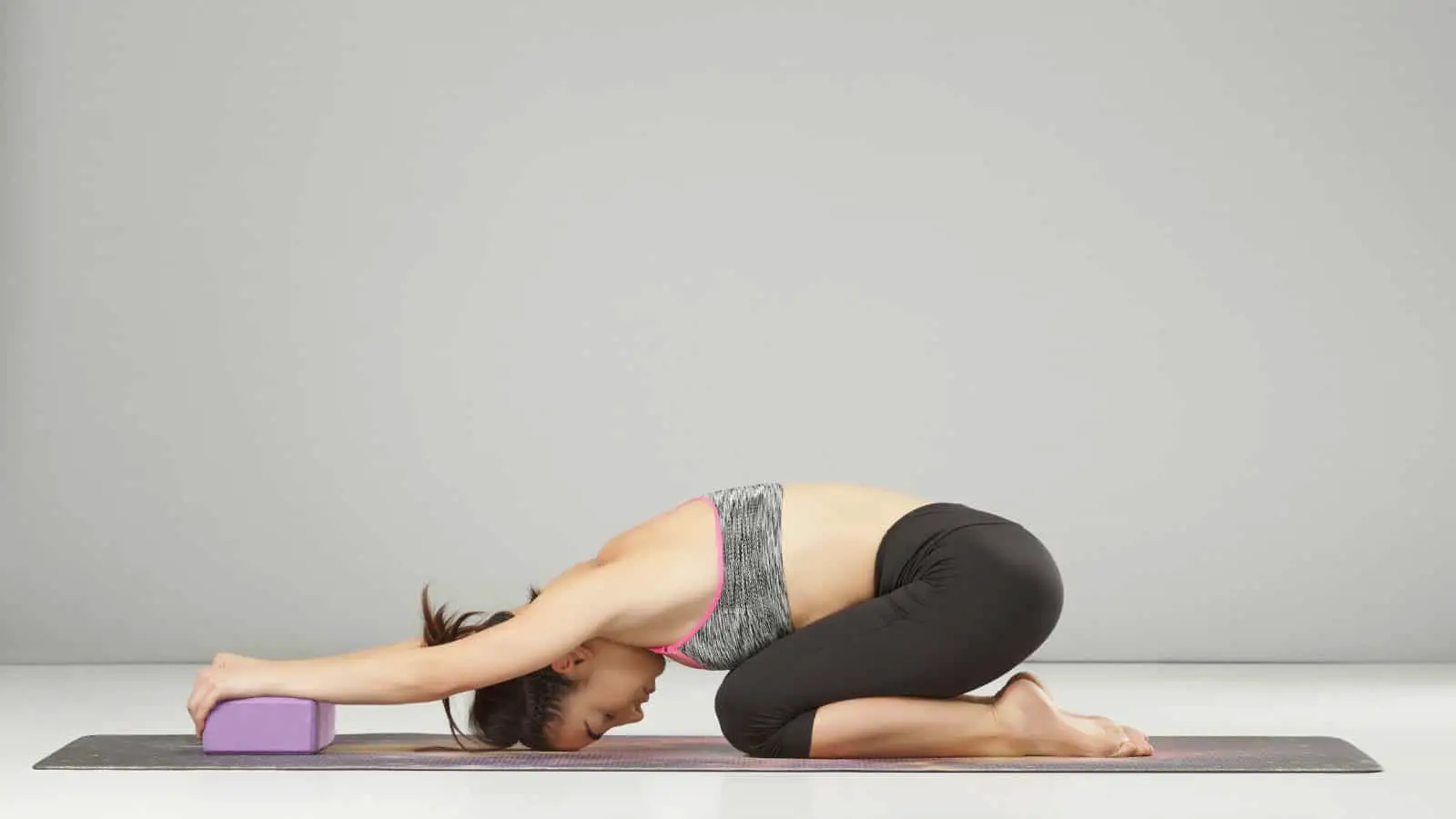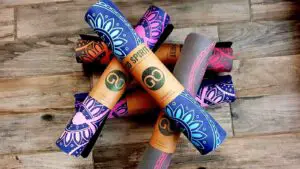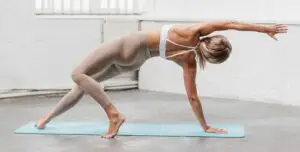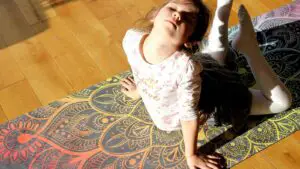Balasana, or child’s pose, is a pose you will often return to when it comes to your yoga practice. It is commonly used as a resting pose and is a well-practiced position in many different types of yoga. However, if you are not finding this shape comfortable and are unable to rest as in it as you believe you should be able to, what’s gone wrong?
If you can’t do balasana, it could be due to an injury, tightness in key muscle groups, or even the mindset with which you are approaching this position. By bringing modifications to this pose and slowly opening your body and mind to the shape, you will be able to make progress with balasana.
In the rest of this article, we will look at some of the reasons people find balasana uncomfortable. Additionally, we will explore what can be done for each of the issues. We will also see the benefits of this particular asana and why you should continue to find your way into this resting pose.
Why You Can’t Do Child’s Pose
If you find yourself unable to sink deeply in a child’s pose, first, it’s important to get a sense of why you are struggling in this pose. As mentioned above, it could be due to an injury or too much tightness in a few different muscle groups. These areas can include your hips, lower back, or calves. It can also be a matter of mindset. If you are forcing yourself too much, it may actually be preventing you from finding the position naturally.
You can think of balasana not just as a pose in and of itself but as a way to check in with your yoga journey. The more you practice and the more you restore and open your body, the more you will be able to sink deeply in this position. There is no rush to achieve a particular shape with this asana, but rather use it as a way to measure your progress and accept where your body is at every step along the way.
Due to Injury
If you have ever suffered from a knee injury, you may be able to imagine how practicing balasana would be complicated and perhaps even dangerous. For any knee injury or chronic condition that doesn’t allow your knee to comfortably bend to its full extent, practicing the traditional version of this asana can be hazardous to your joint health.
It can make your injury worse due to your weight being applied to your legs, forcing them to bend completely.
Modifications for Knee Injuries
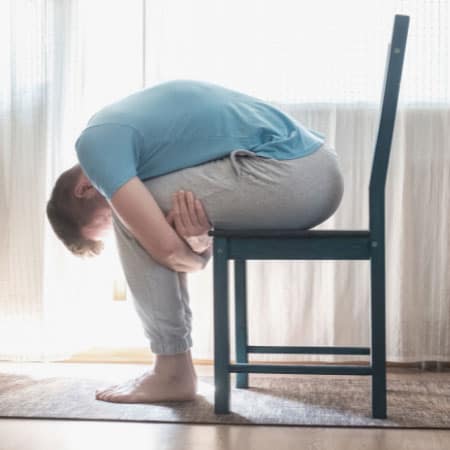
If this is your case, the good news is there is a modification that will work well for any sensitive knees. For this modification, lay on your back and bring your knees up toward your chest. You can place your hands on the back of your thighs, below the knees. Allow your knees to bend only at an angle that is comfortable for them. Draw your legs in towards your chest, breathing deeply, and taking special care to make sure your knees are safe and comfortable.
There are other ways variations of this pose can be done by those who need to take special care with their knees. This modification is better for your home practice but can be possible in a yoga studio equipped for it. It will require two chairs. Sit in the one chair, as usual, and position the other chair’s back in front of you. Lean forward and rest your head and arms on the back of the second chair.
Either of these modifications allows you to continue practicing balasana in a way that is accessible to your body at this time. As your yoga journey continues and your injuries heal, you may be able to progress to the more traditional practice of the asana. However, there is no rush. Either of these modifications allows you to continue your practice without having to skip the rest that balasana has to offer.
Due to Tightness
There can be tightness in a few areas of the body that will impact your ability to do balasana. By slowly, over time, increasing the openness and flexibility in these areas, you will be able to move into a child’s pose more comfortably. Until you reach that point, you can do some different modifications to honor where your body is currently in your yoga journey.
Tightness in the Ankles
Resting in balasana requires a certain amount of flexibility in your ankles and the top of your foot. If you are struggling with this pose due to tightness in this area, you can try to place something soft between your mat and the tops of your ankles. By putting some additional cushioning in this area, you will be able to rest comfortably while relieving your ankles of any unnecessary pressure.
Modifications for Tight Ankles
To do this modification, you can use a rolled-up towel or blanket or anything that will provide the right amount of cushioning for your feet and ankles. If you are attending a live yoga class, you can prepare your prop before practice begins and keep it beside your mat. Then, when it is time for balasana, you will not need to interrupt the flow of your practice to make your modification.
Tightness in the Hips
Tightness in the hips is perhaps the biggest reason why people cannot rest comfortably in balasana. If you are experiencing tightness in the hips, you may notice your hips are quite far above your heels. It may feel like there’s no way that your hips could comfortably rest on your heels one day.
There’s no need to stress–with time and practice, you will notice the position of your hips naturally lowering. However, until then, try this modification to practice more comfortably.
Modifications for Tight Hips
Take a pillow or a cushion and place it between your heels and your hips. This prop should close the gap that currently exists in the shape. This modification should bring support to your hips so you can rest more comfortably, breathing deeply into the posture.
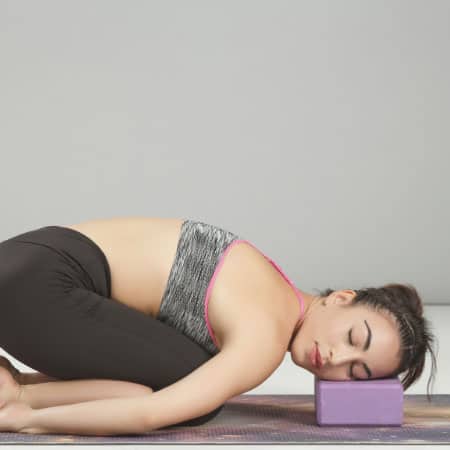
If you are struggling with sinking your hips back, you may also be struggling with where to place your head. It may not be able to rest your forehead on the floor comfortably. In order to alleviate any head and neck strain, you can stack your fists, one on top of each other, on the mat. Place your forehead on the support you have created. You could also use a block to accomplish this head and neck support.
Additionally, for those of us with our hips lifted in the child’s pose, adjusting our arms’ position can be very useful. Typically, the arms rest alongside the body in this posture.
However, by bringing the arms forward and allowing them to stretch out in front of you, you can help your balance in this posture and ultimately feel more comfortable. Because lifted hips can feel like the body has been tilted forward, you can counter this feeling by changing your arms’ placement.
One more modification when it comes to hip comfort and flexibility has to do with the placement of the legs. Traditionally, the legs are placed together, and the body folds over them directly. However, this is not the only way to practice this pose.
You can also do a wide-legged child’s pose. This means that instead of your legs folded under you, you send them out to each side and sink into the resting posture. It will target slightly different muscles, but both variations are deeply beneficial and restorative postures. You can choose which one is more comfortable for your body and your own unique hips.
Due to Mindset
Coming into balasana is usually considered a chance to rest and restore. It is time to let your body absorb the benefits of your yoga practice. It may be a place to spend a few breaths between different sets of asanas or a cooling posture included at the end of your practice. Wherever balasana usually shows up for you, you are likely to want to take full advantage of its calming and resting power.
However, if you move into this position and start to feel stress and anxiety over the fact that your bottom isn’t making it down to your ankles, you may be making it more difficult for yourself. The more we force and try to push our bodies into the image we have in our minds, the more we pull ourselves away from the current experience and where our body is in that moment.
The next time you move into a balasana and start to feel yourself pushing your body towards your heels more than it would like to go, take a breath. Just allow your body to be in whatever shape it is and allow yourself to breathe there. Wherever you locate tightness and discomfort in your body, simply breathe into those areas and let yourself, with time and breath, sink a little bit deeper into your own natural shape.
It may take a long time to deepen your practice before your hips reach your heels, and that gap is eliminated from your shape. However, this is part of the yoga process. It’s not about looking the way the pose exists in your head but exploring and accepting your body at every moment as you journey into these positions.
The more you can relax and accept the way your body can move right now, the greater progress you will be making in your practice.
Benefits of Balasana
The benefits of balasana are wide-reaching, positively impacting both your body and mind. By gently resting in this posture, you can relieve tension that has accumulated in your upper body. This can include your chest, shoulders, and back.
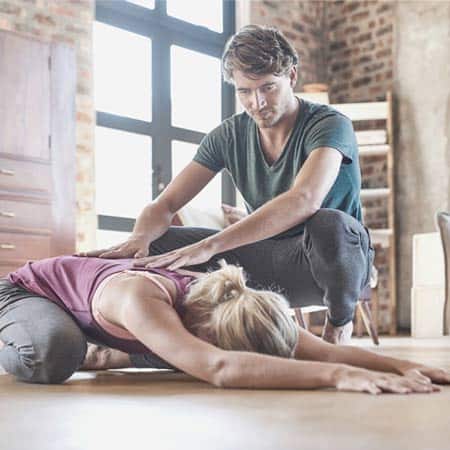
The positioning of the head, allowing it to rest on the floor without tension in the neck, can be a way to combat dizziness as well as anxiety and fatigue. Staying in this position can also bring you into a drowsy-like state of calm, which can be useful for us suffering from insomnia. You can try practicing a child’s pose before bed to help you fall asleep more easily.
This pose also gives your spine a chance to stretch out while helping your circulation throughout your body. You will also be able to feel the gentle stretch in your hips, thighs, and ankles.
Balasana is designed to be a quieting, restful position where you are able to focus inward and give your body a rest. It is also a chance to take a break in class if you have been pushed past your physical edge. If you need to rest for a moment before continuing with the rest of the class, it is typical to come into balasana for a few breaths.
Additionally, due to the positioning of the body, being in a balasana does not allow you to engage in the shallow breathing you are typically doing during your everyday life. This kind of rapid, shallow breathing can be partially responsible for anxiety and lack of calm. By staying in a child’s pose, you will have to dig deeper and breathe more fully to get the oxygen you need.
This deeper way of breathing is more calming for the body, and you will feel its effects after practicing it for just a few rounds. As you are in a child’s pose, inhale fully, expanding your body with your breath and letting it flow out. Keep breathing in this deep, mindful way and take this chance to connect to your life force as it flows in and out.
What Can You Do To Help Your Balasana?
By continuing with your regular asana practice, you will be doing the work you need to open your body and bring more space to the muscle groups that impact balasana. This is to say, the more you deepen your yoga practice, the more you will rest comfortably in this particular pose.
However, if you are looking for a few suggestions of specific poses that will help you sink your hips back further, we have a few suggestions for you to follow. Here are a few asanas you can focus on to help your shape in a child’s pose.
Wide-Angle Seated Forward Fold (Upavistha Konasana)
This beautiful forward bend is so beneficial for flexibility, especially where it counts in balasana. Coming into this position will bring a deep stretch to your inner thighs and hamstrings. It will deeply open up your hips and your back body.
This goes beyond just your back muscles and encompasses the whole area from your heels to the top of your head. It will also massage your inner organs while giving your spine a chance to stretch out and expand.
To do this position:
- Begin sitting on your mat with your legs extended in front of you.
- From here, open your legs out to the side, as far as they comfortably go. There is no need to force any kind of shape here. You should be able to sit up straight comfortably with your legs in this position.
- From here, bring your attention to your legs. Check to see if your heels are grounded down into the mat with your toes pointed up. When you feel your legs actively engage, it’s time to move your attention to your upper body.
- In order to do this bend safely and effectively, you will want to start by engaging your core. The muscles of your core will support your lower back as you lower into your fold. As you come forward, remember that you are hinging from the hips and engaging in the legs to safely and accurately come into the pose.
- Use your breath to guide yourself into the pose. You can move down a little bit further as you exhale. Remember to keep your spine long and avoid hunching over. Breath into this beautiful posture, bringing breath to your hips, spine, and anywhere else you can feel the sensations of this position.
Wide Legged Forward Fold (Prasarita Padottanasana I)
This is another great forward fold to open the hips while stretching the back, spine, and inside of the legs. Since you are lowering the head below the heart, it is also an excellent posture for circulation and for calming the mind. This is a similar posture to the seated forward bend we just explored but can be more accessible for beginners and those with tight hips.
Gravity will also assist you in this position as you allow the weight of your body to guide it towards the mat. Let’s take a look at how to practice this position. To begin:
- Stand on your mat.
- Step your feet apart so they approximately 2 – 3 feet away from each other. If you have more mobility in your legs, you can step your feet further apart.
- From here, engage the arches of your feet. Bring your awareness to the outer edges of your feet, bringing energy up from the floor. Your legs and feet should be active as you move into this pose.
- Now, hinging from the hips, keep your legs as they are and begin to move into a forward fold.
- You want to remember to keep your back straight and avoid curling in the spine. Sometimes it can be tempting to hunch over to get to the ground faster, but this is an incorrect way to move through the posture. Your back must be long and flat, and the fold should come from the hips.
- If you are struggling with keeping your back flat as you reach towards the ground, you can bring in a block to have the ground come up to meet you. This use of a prop will allow you to keep your alignment while making supportive contact with the ground (well, in this case, your block).
- Use your breath to help keep the front of your body strong and active while the back of your body stretches.
- When it comes time to move out of this pose, move slowly and with awareness, slowly rolling up to your wide-legged standing position.
For an in-depth tutorial of how to do this pose safely and with correct alignment, you can check out this video on Youtube:
Tree Pose (Vrksasana)
This standing position will improve your balance and concentration and is a wonderful pose for opening the hips. To do this pose to help the shape of your balasana, you will want to focus on how your hips turn out as you bring your leg to rest above your thigh. This is the part of the pose that will be most helpful with balasana.
So, how can you get started in Tree Pose? Here’s how:
- Begin by standing on your mat in Mountain Pose.
- Take a few breaths to connect with your body, as this pose will require inner calm to stay balanced.
- When you are ready, lift your right foot and place it on your left thigh. Ideally, it should be placed as high as possible, but this is something you can work towards over time.
- You can place your hands at your heart in the Anjali mudra.
- Bring your attention to your right hip, letting your right hip point shine forward as your right leg turns out. The more expansion you bring to your hips in this pose, the easier your balance will be.
- From here, you can bring your hands, still pressed together, above your head. Keep your attention on your breath and the position of your hip to keep your balance.
- To come out of the posture, slowly bring your hands down, and with slow control, release your foot back to the mat.
- Repeat this posture with the other foot as well.
- Remember to pay special attention to the positioning of your left hip when performing this asana on the other leg.
Pigeon Pose (Eka Pada Rajakapotasana)
Pigeon Pose is one of the most well-known hip openers. This deep and beautiful stretch is great for your psoas and other hip flexors. It also targets your outer hips and rotators. Spending time in this pose is a great way to release tension in your hips and increase flexibility.
To try this pose for yourself, follow these steps:
- Begin in a downward-facing dog. From here, you can move into the position with the best alignment.
- On an inhale, bring your left leg up and bring it forward. You should aim to place your left ankle behind your right wrist at a comfortable angle for your knee.
- Ideally, this front leg should be parallel to the front edge of your mat. However, if you are not there yet, don’t worry about keeping the knee bent more than 90 degrees. Make sure that your knee is out away from your hip, towards the edge of your mat.
- From here, take your back leg and move it back a bit, allowing it to remain straight and in line with the hip.
- Take your back foot and lay it down smoothly on the mat. You may experience sensations in your hip and feel the tensions rising up.
- Breathe through these sensations and allow yourself to experience this position fully.
- As you come out of this pose, you will feel the tension melt away and the newly created space in your hips.
Warrior II & Triangle Pose
With poses that require your hips to be turned out, you can use these asanas as a chance to check in with your hips. By taking a few extra rounds of breath in each of these positions, you will be able to focus your awareness on your hips’ positioning. Use your breath to open yourself more, and take the time to be sure your hips are aligned as required in each pose. This will help increase the hip flexibility needed for balasana.
Value the Breath
Part of practicing balasana is noticing how the breath moves specifically in this pose. Because of how your body is positioned, you cannot easily perform shallow, automatic breathing, as we mentioned before. Because of this, the breath can be a wonderful teacher in this position.
When in a child’s pose, you can try to practice ujjayi breathing to help bring full, deep breaths into your body in this position. With your throat slightly constricted, breathe as if you were trying to fog up a window. You should be able to hear the sound of the air moving in and out of your body as well as experience the sensation.
Practicing deep and audible ujjayi breaths can nourish your body in this posture. This pranayama practice will help you sink deeper into the pose. It will also help you practice a way of breathing that will bring your calm and peace that can be practiced on or off the mat.
Final Thoughts
If you feel as if you can’t do balasana, there’s nothing to worry about. Accepting your body as it is today, as well as showing up repeatedly on the mat for your practice, is all part of the yoga journey. Keep returning to this posture, experience it without judgment, and over time you will experience the progress you are looking for in this pose.

